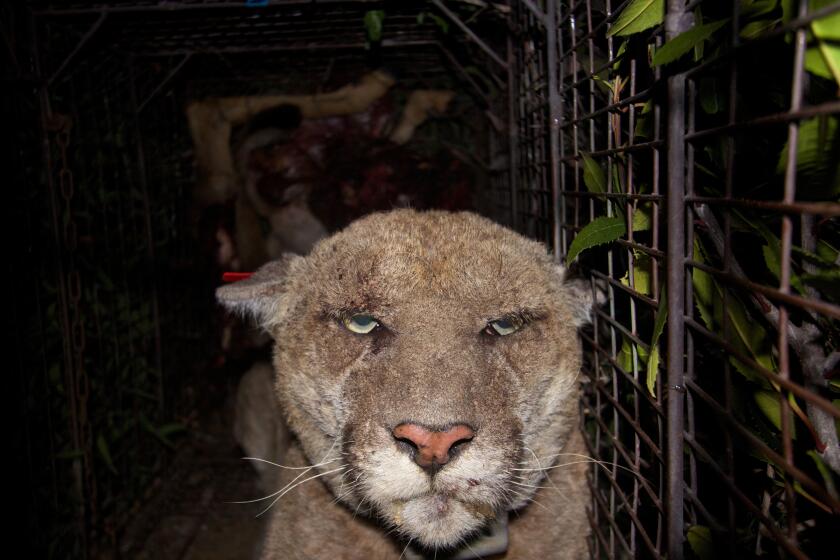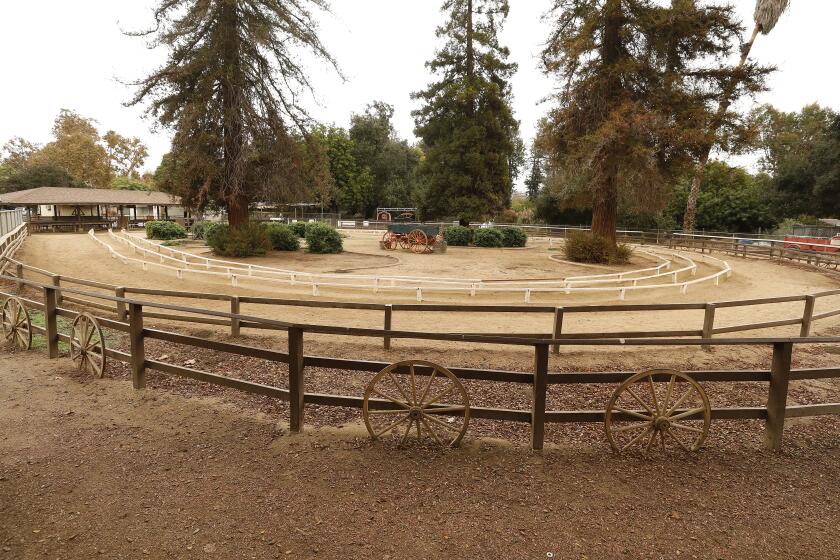Waging a Long Battle to Save a Living Relic : Zoo’s Rhino Breeding Program a Success Story Despite Recent Deaths
Randy Rieches looks at a “crash” of rhinoceroses grazing in the open space of the San Diego Wild Animal Park and explains why the park is engaged in an aggressive effort to breed and distribute the big beasts.
“You have to keep this species in front of the public to keep awareness heightened about the trouble the rhino is in,” said Rieches, the park’s curator of mammals.
News about rhinos was in front of the public last month, but not the kind that Rieches or other officials at the Wild Animal Park or its sister organization, the San Diego Zoo, anticipated.
The news was about the mysterious deaths in China of two southern white rhinos being trucked to Chengdu after a flight from New York to Shanghai, a flight arranged and paid for by the San Diego Zoological Society. The society had purchased a pair of rhinos from the Pittsburgh Zoo after Chinese zoo officials asked for help in increasing their rhino collection.
The deaths--which were kept secret for six months and only became known after an American reporter in China checked out a rumor--left San Diego officials more than a little chagrined.
And lost in the controversy over the China fiasco was the fact that the rhino breeding program at the Wild Animal Park is one of the most successful captive-breeding programs for any species at any zoo and that the San Diego Zoological Society is recognized as a leader in promoting rhino research and conservation efforts in the wild.
“When it comes to rhinos, San Diego is number one,” said Becky Hargis, curator of mammals at the zoo in Knoxville, Tenn.
Rhinos born at the Wild Animal Park, located in a verdant valley 20 miles north of downtown San Diego, are now in dozens of zoos in the United States and 15 other countries, including the zoo at Canton, China. Five years ago the zoological society sponsored the first-ever scientific conference on the biology of rhinos.
Scientists from the San Diego Zoo and Wild Animal Park have provided technical assistance to conservation efforts undertaken by African nations that are trying to prevent the rhinos’ demise by establishing game preserves and invoking strict anti-poaching laws.
As long as 35 million years ago, rhinos roamed much of Asia, Europe, Africa and North America. A rhino cousin, the “giraffe rhino,” was the largest mammal on earth, 20 feet long and taller than a double-decker bus.
“Rhinos are really relics of the Pleistocene Age,” said Eric Dinerstein, chief scientist for the World Wildlife Fund.
Only five species of rhinos have survived into modern times: the black rhino (mostly in Tanzania and Kenya), the white rhino (in southern and northern Africa), the Indian rhino, the Javan rhino (in Indonesia and Vietnam), and the Sumatran rhino (found in Borneo and Sumatra).
All but the southern white rhino are on the endangered list and even the southern white is only one notch safer, on the “threatened” list after a dedicated preservation effort by the South African government.
Of the African rhinos, the black rhino is the most in peril; its numbers have dwindled from a million at the turn of the century to only a few thousand now. Warfare and urbanization have taken a heavy toll on the rhinos.
Much of the slaughter of rhinos in Africa and Asia is attributed to the black market trade in rhino horns. Poachers hunt rhinos with AK-47s and chain saws. Orders by some African governments that poachers can be shot on sight by game wardens have slowed but not ended poaching.
Folk tradition dating back thousands of years asserts that the rhino horn, ground into fine powder, can cure a variety of ills, particularly of the sexual variety. In North Yemen, rhino-horn daggers symbolize masculine power.
The mystique of the rhino is based, in part, on the size of the male genitalia and the vigor with which the two-ton animals engage in congress, beginning with a kind of combat that can leave both scarred by horn butting.
Shops in Singapore, Hong Kong, Macao, Taipei, South Korea and elsewhere do a brisk business in rhino horns. For poachers, a pound of rhino horns can fetch upward of $10,000.
When news of the deaths of the two rhinos in China leaked out, suspicions were raised that the beasts died not from heatstroke but at the hands of poachers. Such suspicion was fueled by the Chinese refusal to provide documentation about the deaths.
“You find out what happened to the horns and you’ll know what happened to the rhinos,” saidRichard Farinato, captive wildlife protection program director for the Humane Society of the United States.
Since 1972, more rhinos have been born at the Wild Animal Park than at any other zoo in the world: 82 southern white rhinos, 23 Indian rhinos and eight black rhinos. All but a few have been shipped to other zoos.
Rhinos that have spent years at other zoos without breeding are sometimes shipped to the Wild Animal Park for one last chance at making a splash in the gene pool. Unlike the smallish pens at most zoos, the park offers wide-open spaces; its nine Indian rhinos can roam over 58 acres landscaped to look like home.
If new surroundings don’t do the trick, Rieches and his staff will try behavior management with their rhinos, and sometimes drugs to enhance the male’s ardor or female’s receptivity.
“We’ll try anything to get a successful breeding,” Rieches said.
As a result of the Wild Animal Park breeding program and a similar program undertaken by the American Zoo and Aquarium Assn., rhinos are more plentiful at zoos and similar institutions than ever before--leading to the irony of the rhino population shrinking in the wild but increasing in captivity.
“If it were not for zoos and other institutions that are holding rhinos, I don’t think the plight of the rhino would be understood by the American public,” said Michael Fouraker, collection director at the Fort Worth Zoo. “African countries don’t have large budgets for public relations.”
Despite two decades of study, there is much scientists do not know about rhinos.
Rhino communication is still a mystery. There has never been a successful artificial insemination of a rhino, possibly because the female’s reproductive tract is so long and complex. Also, captive-born female rhinos are not as likely to breed as wild-born females.
“In many ways we’re living in parallel universes with the rhino,” said Oliver Ryder, geneticist and rhino expert at the San Diego Zoo’s Center for the Reproduction of Endangered Species.
In zoo lingo, rhinos are “plant-eating mega-fauna” and a flagship species. “They’re like the panda and the elephant,” Ryder said. “If we can interest people in saving them, we can interest them in saving an entire ecosystem.”
So far, no captive-born rhinos have been returned to the wild, although Fouraker’s zoo is part of a consortium working with the governments of South Africa and Zimbabwe to possibly release to Africa black rhinos born in captivity in the United States.
The death of the two Pittsburgh rhinos in China was a public relations black eye for the San Diego Zoo, which touts itself as “world famous.”
Officials were chagrined that Chinese zoo officials reneged on a promise to send the rhinos by rail from Shanghai to Chengdu rather than attempt a five-day truck trip in the summer heat. Also, a promise by the Chinese to keep a rhino specialist with the pair throughout the 1,650-mile trip was not fulfilled.
Henceforth, the San Diego Zoological Society will insist on sending a specialist with any rhino being transported. But there will be no backing down from a vigorous program of sending rhinos--and other animals--to far-flung parts of the globe for breeding and display.
“Nobody exports or imports as many animals as we do,” Rieches said. “We’re good at it, and we’re going to continue doing it. It’s important.”
More to Read
Sign up for Essential California
The most important California stories and recommendations in your inbox every morning.
You may occasionally receive promotional content from the Los Angeles Times.










